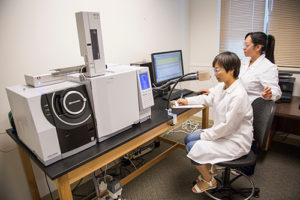With the right certifications, they’ll become one in a billion
What gives orange juice its sunny zing?
Texas Woman’s University (TWU) flavor chemist Dr. Xiaofen Du explains it this way: “Generally, if you eat something, you identify three to four flavors. But if you get trained, you will pick up much more and become sensitive [to taste].”
It’s Du’s job to study the chemical breakdown of foods, finding the individual components that make up taste and aroma. Once known, she can replicate flavors in the lab to find ways to amplify natural flavors or create entirely new ones.

Her research skills spurred a partnership with Keurig Dr Pepper that resulted in the creation of TWU’s flavor chemistry program. Du, who joined TWU in 2017, is passing on her expertise to students in the school’s program, which started the same year she arrived at the university.
It’s the only flavor-chemistry-focused university food science program in the U.S., according to Shane Broughton, chair of TWU’s Nutrition and Food Sciences Department. The Denton university also has one of the few flavor chemists in Texas.
rior to coming to TWU, Du worked as a senior research scientist in China at Firmenich Aromatics, the world’s largest privately owned flavor and fragrance company, with numerous research and development awards to its name, including a Nobel Prize in chemistry.
“It’s not easy to learn,” Du says. “We deal with a lot of compounds you have to memorize. You have to connect those chemicals to real perceptions.”
Becoming a flavor chemist, or flavorist, requires rigorous training, including a seven-year apprenticeship. Broughton says there are currently only hundreds of certified flavorists in the world.
At TWU, students can earn a master’s degree in flavor chemistry or a Ph.D. in nutrition with an emphasis in flavor chemistry. It’s the background that students would need to eventually become certified flavorists if they choose.
Broughton says, “We want to make sure we are training them according to what the job-market needs are in this immediate environment.
This article is part of the 2020 Higher Education Review Magazine.